Russia’s invasion of Ukraine has left American politicians once again hurling familiar slogans at each other: “Drill, baby, drill!” vs. “Invest in renewables!” Still, everyone agrees we need more clean energy, and surely we can all agree that we should be smart about it – meaning, we should design energy programs to get the most bang for the buck.
Unfortunately, our current federal subsidies for electric vehicles (EVs) are not making the most of the investment. That is, they are not maximizing climate benefits. Or cutting air pollution. Or energy security. Or fairness. Or normalizing EV use. We can, and should, do better.
To see why, look at this chart. It shows how much gasoline the current EV subsidy system is likely to displace from our energy system (red area in the graph below) compared with how much we could displace if we adopted a more targeted approach (teal area). As I’ll explain below, this analysis is based on data from the nonprofit Coltura and the University of Washington, which I’ve applied to projections about car sales in coming years. It implies the possibility of not just a more efficient climate policy but also a different climate politics.
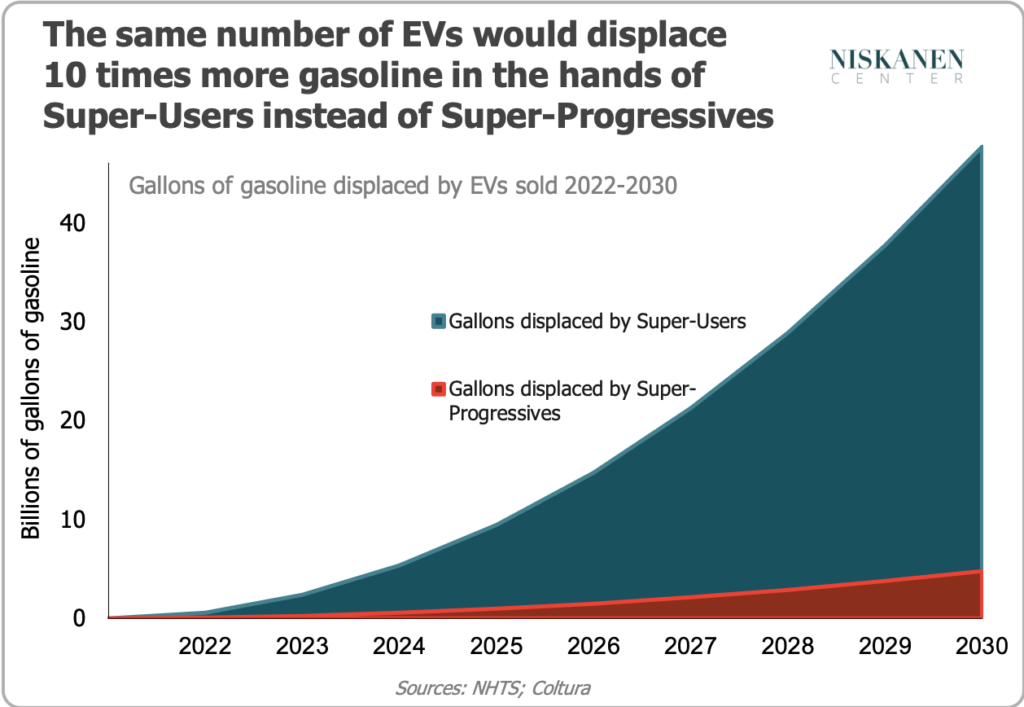
EV subsidies can only help a fraction of car-buyers right now
The main reason for subsidizing EV purchases is to reduce the amount of gasoline we burn in cars and enjoy all the subsequent benefits: less climate pollution, less air pollution, and less dependence on unstable and expensive fossil fuels. Subsidies should help make EVs accessible to people who might not otherwise be able to afford them. In turn, their purchases replace more internal combustion engines and (hopefully) show their friends and neighbors how great EVs are, thus convincing a new wave of people to consider one next time they are in the market for a vehicle.
There are 250 million cars, SUVs, and light-duty trucks in the U.S., and together, they burn nearly 135 billion gallons of gasoline each year. EVs make up less than 1 percent of the light-duty fleet. Automakers expect more than half of new cars to be EVs by 2050, but even then, most cars on the roads will still burn gasoline. That’s because only about 17 million new vehicles are sold each year, and most vehicles stick around for decades, so fleet turnover takes a long time. To electrify the whole fleet within 30 years, we need to stop selling any non-electric vehicles by 2035. Some states require all new vehicles to be EVs by 2030 or 2035, but it would be a stretch to imagine that happening nationwide.
The decades-long fleet turnover timeline is long compared to the urgency for climate action. So while the question of how quickly we electrify the fleet is important and the more states that move fast the better, it is also essential to ask who goes first. Who should be at the front of the line to get those precious, earlier EVs that will be on the roads for this critical decade when trying to avoid climate tipping points?
Well, the folks at Coltura and researchers at the University of Washington have an answer: the top 20 percent of drivers, who generate 48 percent of the emissions. In fact, Coltura calls the top 10 percent Super-Users because they consume 32 percent of all the gasoline sold.
Super-Progressives vs. Super-Users
Let’s consider two scenarios.
We’ll call the first scenario the Super-Progressives scenario, in which EVs go to committed progressives who want to take action on climate by driving a Tesla. They tend to be higher-income and live in more urban environments and if they couldn’t get a Tesla they would drive a relatively fuel-efficient vehicle, like a Toyota Prius or maybe a Volvo. On average, they burn about 100 gallons of gasoline per year.
We’ll call the second scenario the Super-User scenario, in which EVs go to the people who are burning the most gasoline. They are more likely to live in rural areas or at the suburban and exurban fringes of large metro areas and drive SUVs or pickup trucks. And they drive them a lot, burning on average 1,000 gallons of gasoline per year.
Assuming car sales increase from 17 million per year to 20 million per year in 2030, and half of the cars sold in 2030 are electric, then 10 million new EVs would be sold in 2030. If EV production ramps up smoothly from its current levels of around 600,000 per year in 2022 up to those 10 million per year in 2030, we will add nearly 50 million new EVs by the end of the decade. And if all those new EVs went to Super-Progressives, we’d displace around 17 billion gallons of gasoline over those eight years (the red area in the graph above). But if the new EVs all went to Super-Users, the total would be ten times as high: about 170 billion gallons of gasoline in eight years (the teal area in the graph above).
Now consider the annual displacement we will have achieved by 2030. In the hands of Super-Users who would otherwise have burned 1,000 gallons of gasoline per year each, this new fleet of EVs would displace nearly 50 billion gallons of oil use at the start of the next decade. That would get us most of the way* to the annual gasoline-use reduction we would need to be on the path to a 50 percent drop in greenhouse gas emissions by the end of the decade. This is a target set by the Biden administration to harmonize with what the Intergovernmental Panel on Climate Change says we need to do to prevent the most catastrophic outcomes from global warming.
In the context of our current energy politics, the Biden administration plans to release 180 million gallons over six months from the emergency reserve. We could effectively increase the available supply by the same amount simply by getting EVs to 360,000 Super-Users. And the reserve release is a one-time shot — we have to figure something else out for the next six months, and the next. In contrast, the Super-Users in EVs would release millions of gallons every six months for a decade or more (however long their EV lasts). By 2030, EV Super-Users could be displacing nearly 50 billion gallons of gasoline every year — more than 250 times the amount Biden is drawing from the reserve.
Achieving climate goals by targeting Super-Users for EVs
If we want to achieve a 50 percent reduction in climate pollution from cars and light-duty trucks by 2030 wholly by switching out gas-burners for electric vehicles, we could get there with just 100 million electric vehicles, if those all go into the hands of Super-Users. But suppose Super-Users are last in line to get EVs. In that case we will need to effectively replace the entire U.S. fleet by 2030 — rolling out nearly 250 million vehicles in eight years, a Herculean feat given that fewer than 500,000 EVs were sold in the U.S. in 2021, and that it usually takes more than a decade for the whole fleet to turn over.
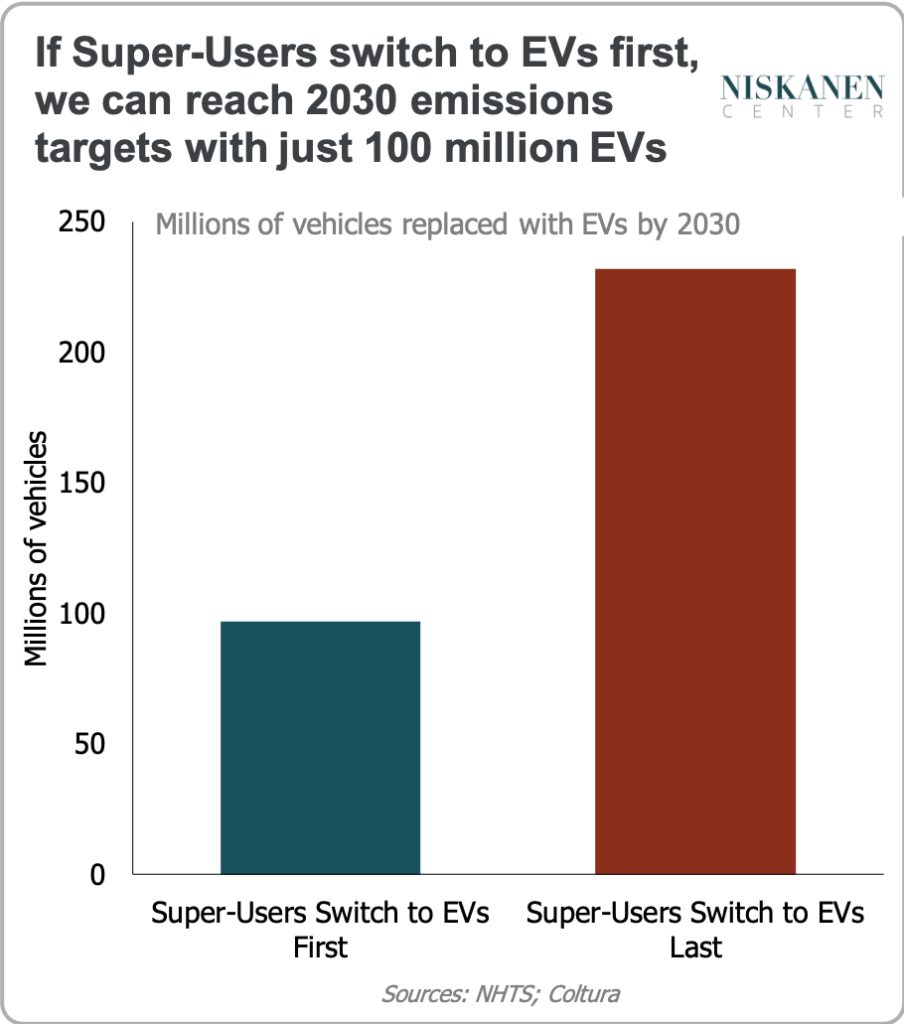
Scrambling partisan politics
As with almost everything these days, partisan politics around EVs are all lined up. People prone to purchasing an electric vehicle tend to live in coastal, blue states and to be more worried about climate change. By providing EV subsidies, their representatives take action on an issue EV-owners care about and direct a larger amount of federal largesse towards blue states.
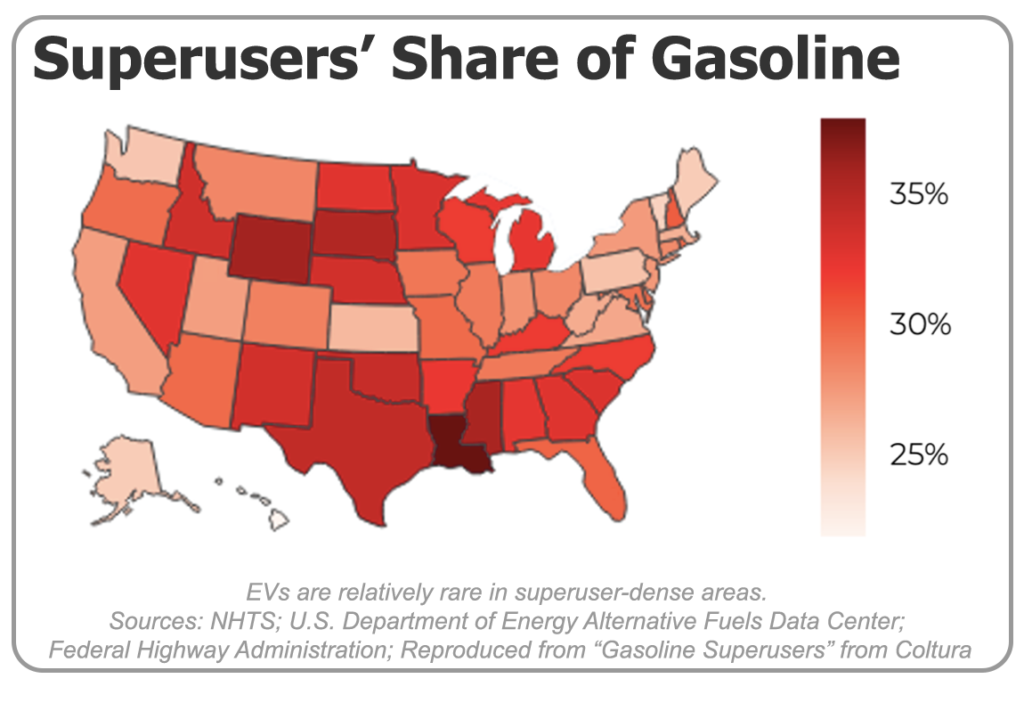
But Super-Users tend to live in red states (darker red in the map above), and more rural, red communities. This creates the potential for a different political dynamic.
Republican members of Congress could switch EV incentives to target Super-Users and then run a victory lap. They can simply let their constituents know they snatched federal money away from latte-drinking elites and captured it for hard-working men and women in their district who have to drive hours for their daily commute or who drive their truck all over town doing construction jobs. Meanwhile, Democratic members can crow to their climate-concerned constituents, celebrating that they’ve tuned the program up to get more climate bang for the buck.
Then a virtuous cycle begins.
Perhaps that contractor previously thought climate change only meant bringing financial pain down on his family, so if his moderate Republican representative dared speak out about climate action, the contractor would swiftly punish him in the primary. But now, with a little help on the sticker price, he’s gotten behind the wheel of an all-electric Ford F-150 and he starts to feel differently. Maybe climate action isn’t a hoax to try to take his truck away, but a plan to get him an even better one. Now when his representative talks about the need for clean, abundant energy, he nods along. Emboldened, Republicans start working in earnest on climate action, which results in even more Americans experiencing the upsides of a clean and stable future.
Meanwhile, vehicle makers see more demand for the larger EVs that Super-Users want, and they start diversifying their offerings. The subsidies help manufacturers move up the learning curve and reduce costs as they produce more vehicles. Still, the vehicles they are producing are attractive to a broader set of Americans. People who weren’t already seeking out an EV due to their political leanings start seeing vehicles they like and getting in line to buy one. They also start to feel that transitioning to clean energy is a good idea.
Fairer
Current EV drivers tend to have high incomes (green bars, below) and EV ownership is disproportionately high in the over-$200,000-per-year households. By contrast, Super-Users’ income distribution (red bars below) looks similar to that of average Americans (blue bars). The upshot is that the current EV subsidy is disproportionately benefiting wealthier households.
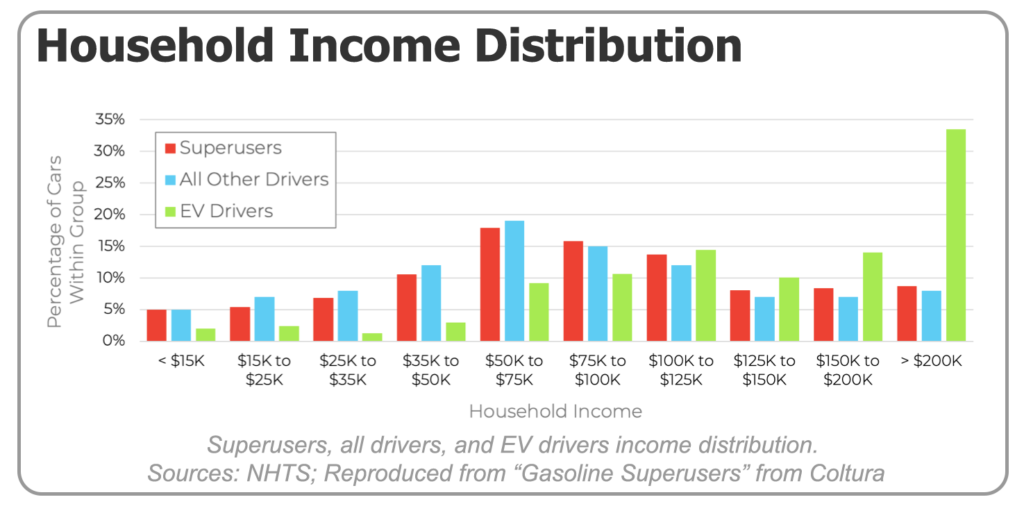
Super-Users’ income looks like other people’s, but because they drive so much, they pay a larger percentage of their income on gasoline – more than 8 percent, compared to most Americans who pay well under 3 percent. Democratic representatives are right to want to ramp up EV production and tamp down our dependence on oil, but did they mean to subsidize the highest-income Americans?
Reforming EV subsidies to target Super-Users would make them more equitable, helping less well-off Americans, and particularly those hit hardest by big payments at the pump.
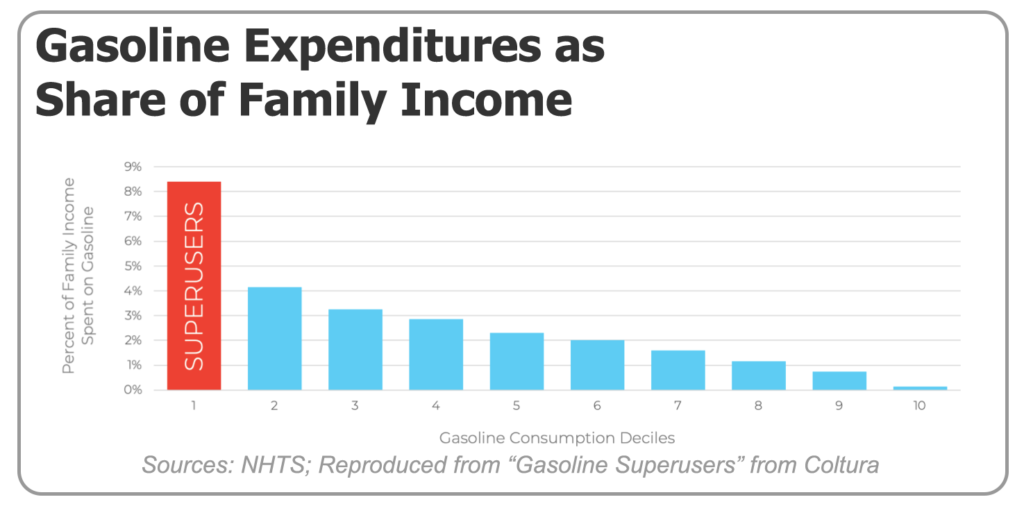
A straightforward policy mechanism
The current federal subsidy of $7,500 goes to any EV purchaser, no matter how much (or little) they will utilize the clean vehicle. Instead, the federal government could base the subsidy on how much that vehicle owner actually drives, aiming to get the most displaced gasoline for each federal dollar spent. Thankfully, the mechanisms for measuring and verifying gallons displaced are straightforward and well-established. Every vehicle comes with an odometer and an official EPA miles/gallon estimate. Each time a car is sold, the odometer reading is recorded. So a car or truck owner must only show how many miles their vehicle has on it now, how many miles it had when they bought it, divide by the number of years they’ve owned it, multiply by the car’s miles/gallon rating and voila! You have the average number of gallons of gasoline that car has burned every year that this person has owned it. If they buy a new electric vehicle, the federal government pays them based on the number of gallons of gasoline they have a track record of burning.
Coltura, the nonprofit working on this policy, has proposed a $10/gallon incentive. For a Ford F-150 that averages 40,000 miles per year and 20 miles per gallon, that would mean a $20,000 incentive for a new electric vehicle, or a good chunk of the cost of an electric Ford F-150 Lightning. Combine this with the considerable ongoing fuel and maintenance savings from owning an EV rather than a gas-burner, and switching to an EV would look very attractive to many Super-Users. The federal government would be paying out more for this vehicle than now, but getting more gallons displaced by getting a Super-User driving a Lightning instead of a gas-powered F-150.
And the program would save money by shrinking the subsidies for Super-Progressives. An urban Prius driver who only racks up 8,000 miles per year at 50 miles per gallon would get a $1,600 incentive towards a new electric car, saving the program nearly $6,000 per similar vehicle.
If we assume that the current $7,500 per-vehicle subsidy is not attracting Super-Users, but that a $10/gallon subsidy would entice them to switch to EVs first, then the cost savings of switching from a per-vehicle to a per-gallon subsidy could be enormous. By paying 100 million Super-Users $10/gallon to switch to EVs, we could achieve a 50 percent reduction in gasoline use in 2030 for a total federal subsidy of $800 billion. But if we keep paying non-Super-Users $7,500 per vehicle, the federal government needs to keep paying until 250 million EVs are on the roads. Even if we could make that many EVs by 2030, Coltura estimates the subsidy cost would be nearly $1.8 trillion. That $1 trillion could be better spent boosting the billions the bipartisan infrastructure bill dedicated to electric charging infrastructure, which should build out charging infrastructure near Super-Users, ensuring that the new EV drivers have plenty of options to charge up.
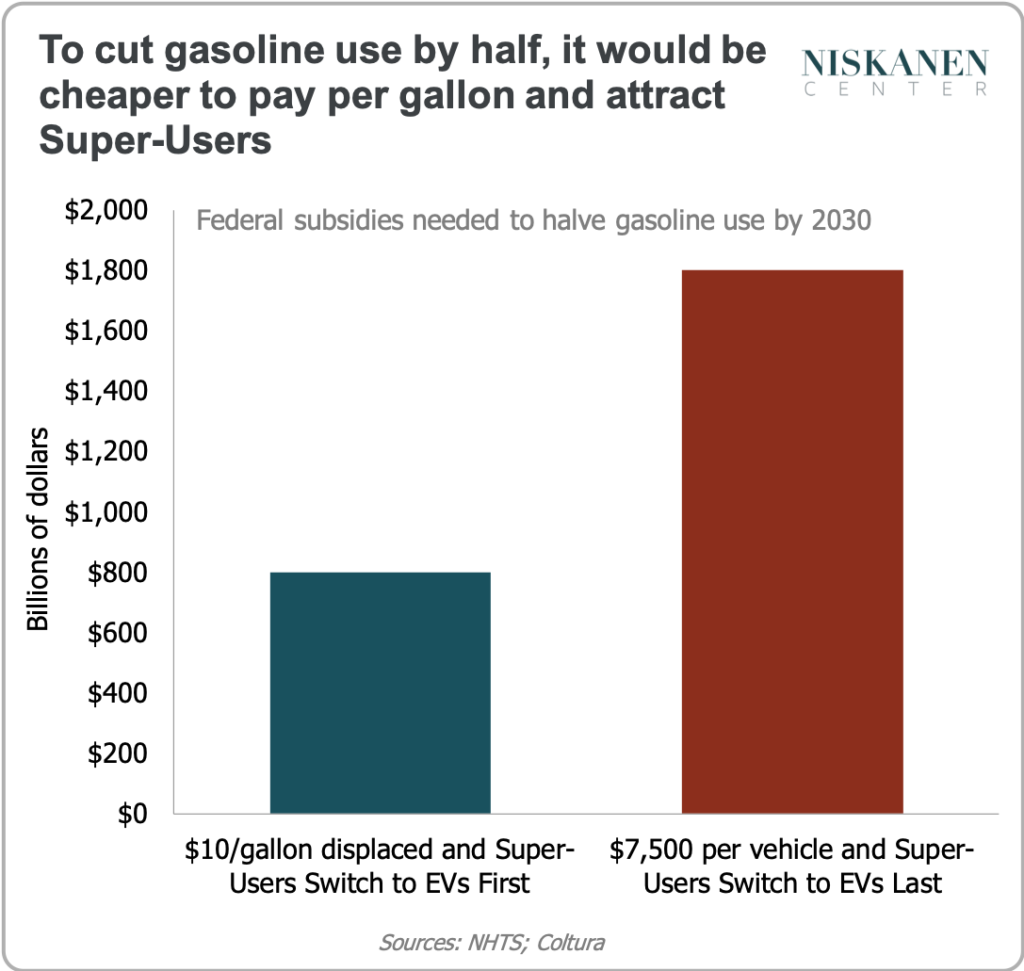
Better policy design might also be better politics
No matter how you slice it, subsidizing by gallon displaced seems better than subsidizing by vehicle purchased. It keeps the subsidy focused on displacing gasoline; it is fairer, distributing the benefits of federal subsidies and lower-maintenance EVs to the Americans who need that help the most; and it has the potential to be many things to many members of Congress. For climate hawks, it is more effective climate policy; for abundant clean-energy advocates, it has a better chance of bringing new EV fans into the fold rather than preaching to the choir; for members focused on social justice it is more equitable; for those most pressured by high gas prices it offers the potential for relief for constituents most impacted by gas prices; and for fiscally conservative members, it offers a more carefully targeted program.
In other words, changing EV subsidies could be just what we need to address the climate crisis, persistent regional inequality, and concerns about oil prices, and to bring the benefits of abundant clean energy to the places that are not yet sold on its potential.
*U.S. light-duty gasoline consumption is expected to be relatively flat in coming decades, at around 135 billion gallons per year. Cutting that in half would mean cutting by about 67.5 billion gallons per year, so cutting 50 billion gallons in 2030 would get us nearly three-quarters of the way towards that goal.